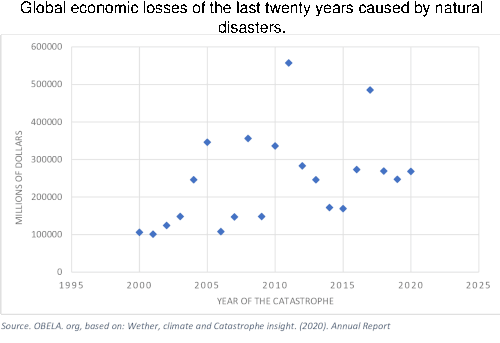The Paris agreement, signed in 2015, is the most ambitious agreement developed among nations to combat climate change. It aims to keep the global temperature level below 2°C above pre-industrial levels and to set targets to limit this increase to 1.5°C.
This article points out that the actions taken by governments are insufficient to slow down progressive climate change. Latin America will be one of the geographical areas most affected economically and socially by this fact. The Latin American climate agenda does not adhere to international standards that seek to mitigate this situation, however.
The nationally determined contributions, i.e. the mitigation goals that countries set themselves, are insufficient to achieve the objectives. According to the 2020 World Meteorological Organisation's Statement on the State of the World Climate, there is an acceleration in climate change indicators. For example, sea-level rise, melting of the poles, and extreme weather events such as hurricanes or prolonged droughts, seriously threaten the socio-economic development of the world's population.
According to the journal Environmental Research Letters, global GDP could shrink by up to 37% by the year 2100 due to climate change. During the first half of 2021, these weather events have cost global insurers more than 40 billion dollars, and the number of people affected by natural disasters expects to double by 2030.

The WMO-generated atlas analysing human and economic losses from climate change says that between 1970 and 2019, 74% of economic damage and 45% of deaths were caused by extreme weather events, mainly droughts and storms. Notably, 91% of deaths from these events occurred in developing countries.
According to the United Nations, Latin America will be highly affected by elements related to climate change such as heatwaves, persistent forest fires, crop losses, among others. The third-warmest year in Central America and the Caribbean, and the second warmest for South America was 2020.
In this line, the executive secretary of ECLAC expressed during a conference that international rating agencies consider climate vulnerability as a criterion for downgrading the rating, which is problematic because this "would increase the cost of public debt and interest payments for developing countries". It will also have an impact on the cost of private international credit and domestic interest rates.
It begs the question: How committed are Latin American countries to GHG reduction, and how ambitious are their goals and policies to reduce the region's vulnerability to climate change? The answer is clear but not encouraging. In the region, post-COVID-19, recovery measures and economic stimuli are not in line with the 2030 Agenda or the Paris agreement goals. Between 2016 and 2019, the average budget allocated to environmental protection by national governments was 0.4%. In 2020, this budget fell to only 0.2%.
Latin American countries have not yet committed to a fundamental energy transformation. Natural gas and oil account for 65% of energy production in the region; these are inputs used to produce gasoline and other fuels. Argentina, Bolivia and Mexico are the countries that use the most fossil fuels as a source of electricity. In Mexico, the energy reform implemented by the government seeks to encourage investment in hydrocarbons.
Finally, risk warning and monitoring systems, especially in Central and South America, are inefficient, as are economic assistance plans. In recent years, Cuba, Haiti and Mexico have been the worst affected by tropical storms, yet Mexico chose to eradicate the Natural Disaster Fund.
The cost of adopting mitigation measures is much lower than what countries, especially in Latin America, will face if they do not soon establish more ambitious policies aimed at meeting the targets set by the Paris agreement. Environmental catastrophes will increase yearly, and the region, which has already been hit hard by COVID-19, does not have the elements to cope. Latin America is currently not seeking to mitigate the climate change effects.









